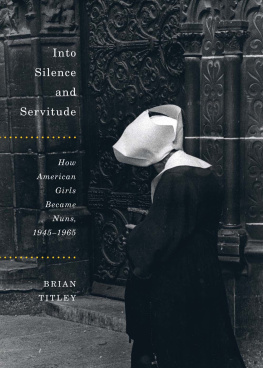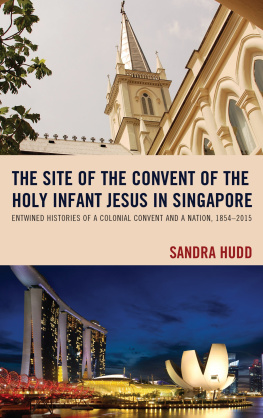Margaret Chowning - Rebellious Nuns: The Troubled History of a Mexican Convent, 1752-1863
Here you can read online Margaret Chowning - Rebellious Nuns: The Troubled History of a Mexican Convent, 1752-1863 full text of the book (entire story) in english for free. Download pdf and epub, get meaning, cover and reviews about this ebook. year: 2009, genre: Religion. Description of the work, (preface) as well as reviews are available. Best literature library LitArk.com created for fans of good reading and offers a wide selection of genres:
Romance novel
Science fiction
Adventure
Detective
Science
History
Home and family
Prose
Art
Politics
Computer
Non-fiction
Religion
Business
Children
Humor
Choose a favorite category and find really read worthwhile books. Enjoy immersion in the world of imagination, feel the emotions of the characters or learn something new for yourself, make an fascinating discovery.

- Book:Rebellious Nuns: The Troubled History of a Mexican Convent, 1752-1863
- Author:
- Genre:
- Year:2009
- Rating:4 / 5
- Favourites:Add to favourites
- Your mark:
- 80
- 1
- 2
- 3
- 4
- 5
Rebellious Nuns: The Troubled History of a Mexican Convent, 1752-1863: summary, description and annotation
We offer to read an annotation, description, summary or preface (depends on what the author of the book "Rebellious Nuns: The Troubled History of a Mexican Convent, 1752-1863" wrote himself). If you haven't found the necessary information about the book — write in the comments, we will try to find it.
Margaret Chowning: author's other books
Who wrote Rebellious Nuns: The Troubled History of a Mexican Convent, 1752-1863? Find out the surname, the name of the author of the book and a list of all author's works by series.
Rebellious Nuns: The Troubled History of a Mexican Convent, 1752-1863 — read online for free the complete book (whole text) full work
Below is the text of the book, divided by pages. System saving the place of the last page read, allows you to conveniently read the book "Rebellious Nuns: The Troubled History of a Mexican Convent, 1752-1863" online for free, without having to search again every time where you left off. Put a bookmark, and you can go to the page where you finished reading at any time.
Font size:
Interval:
Bookmark:

Rebellious Nuns:
Mexican Convent,
17521863
MARGARET CHOWNING
Rebellious Nuns
This page intentionally left blank
Rebellious Nuns
The Troubled History of a Mexican Convent,
17521863
margaret chowning
2006
Oxford University Press, Inc., publishes works that further Oxford Universitys objective of excellence
in research, scholarship, and education.
Oxford New York
Auckland
Cape Town
Dar es Salaam
Hong Kong
Karachi
Kuala Lumpur
Madrid
Melbourne
Mexico City
Nairobi
New Delhi
Shanghai
Taipei
Toronto
With offices in
Argentina
Austria
Brazil
Chile
Czech Republic
France
Greece
Guatemala
Hungary
Italy
Japan
Poland
Portugal
Singapore
South Korea
Switzerland
Thailand
Turkey
Ukraine
Vietnam
Copyright 2006 by Oxford University Press, Inc.
Published by Oxford University Press, Inc.
198 Madison Avenue, New York, New York 10016
www.oup.com
Oxford is a registered trademark of Oxford University Press All rights reserved. No part of this publication may be reproduced, stored in a retrieval system, or transmitted, in any form or by any means, electronic, mechanical, photocopying, recording, or otherwise, without the prior permission of Oxford University Press.
Library of Congress Cataloging-in-Publication Data
Chowning, Margaret.
Rebellious nuns : the troubled history of a Mexican convent, 17521863 / Margaret Chowning.
p.
cm.
Includes bibliographical references and index.
ISBN-13 978-0-19-518221-7
ISBN 0-19-518221-9
1. Purima Concepcio (Convent : San Miguel el Grande, Guanajuato, Mexico)History.
2. ConventsMexicoGuanajuatoHistory.
I. Title.
BX4220.M4C46
2005
271'.97dc22
2005040660
9 8 7 6 5 4 3 2 1
Printed in the United States of America
on acid-free paper
To Irv, Polly, and Sarah
This page intentionally left blank
Acknowledgments
First, many thanks to Sister Mar Lilia of the present-day community of the Order of the Immaculate Conception of San Miguel, whose story gave this book a much better ending than I could have hoped for. Sister Mar of the San Jose monastery of Conceptionists in Guadalajara, Spain, has also shown a keen interest in this book and helped out with technical questions about the order.
In Morelia, the staff of the archepiscopal archive has been warm and welcoming for many years, but was especially helpful on this book. Emelia Hernadez Ramos, Sergio Monjara Martez, and Hugo Sandino Bautista were always friendly and are now friends. Pat and Ben Warren have also been wonderful friends and hosts over many summers in Morelia.
Guillermo G. Engelbrecht of the Instituto Allende, housed in the summer home of Mar Josepha Lina de la Canals family, went out of his way to photograph a lovely portrait of her that hangs in the chapel. Also in San Miguel, Helene Kahn made a valiant effort to track down artwork.
Andrew Paxman and Karen Melvin did legwork in Mexico City for me and willingly added my pile of photocopied documents to their own heavy paper burdens when they returned from field research. Karen also served as a research assistant in Morelia, culling the Santa Catarina documents for statistics on entrances and professions to that convent, and while the work that Nicole Von Germeten did during her research assistantship will mainly be used in another book, in a general way, it helped give shape to this one. Special
viii
a c k n o w l e d g m e n t s
thanks to Jessica Delgado, without whom this book would have had a blank space for a cover.
A number of colleagues, students, relatives, and friends have read all or part of the manuscript and have helped me to write a book that we all agreed should be accessible to general readers, but also adhere to high standards of scholarshipnot always an easy balance to strike. William Taylor and Tom Brady read the manuscript twice, with their customary care and insight. Tulio Halperin-Donghi, Gene Brucker, and Randy Starn were also among the first to give me feedback on how to proceed, once the basic outlines of the narrative were in place. Stephanie Ballenger and Kristin Huffine made a number of suggestions for reading and revision on the section in Chapter 3 on the mal,
the strange affliction from which the nuns in Phelipas faction suffered. Cyn-thia Read, my Oxford editor, helped me see ways to make the story of the mal, and other parts of the book as well, more compelling. Brian Connaughtons generous and close reading improved the manuscript and reinvigorated my enthusiasm for my original project on women, the church, and politics. At a later stage, Mark Healey, Yuri Slezkine, and Peggy Anderson offered suggestions, insights, and encouragement. My lay readers were my mother, Pat Chowning, who also helped tabulate some of the figures from the Santa Catarina convent, and Sue Kern, my college roommate and a better history major than I was. Martha Barber has always protected my best interests, and did so in the context of this book as well. Now that Sarah and Polly are in college and wading through many more books each week than they ever did in high school, they have been transformed into advocates for readability and brevity.
Most of all, though, my husband, Irv Scheiner, has been adviser, critic, and cheerleader from the very beginning. When I started coming back each evening from the archive with stories of what the rebellious nuns did today,
it was he, speaking as a fellow historian caught up in the excitement of the archival chase, who first said that I had a book (one that I hadnt intended to write). His good nature prevailed through spending our honeymoon in San Miguel, a town whose hills and cobblestones and narrow sidewalks give his knees fits, so that I could tie up a few last loose ends, and he kept his mouth mainly shut when I announced that I needed another trip back in the summer of 2004, to tie up the last of the last of the loose ends. Many thanks and much love.
Contents
x
c o n t e n t s
Rebellious Nuns
This page intentionally left blank
This book came about accidentally. In 1999, in the early stages of researching a project on women, the church, and politics in eighteenth- and nineteenth-century Mexico, I stumbled upon a bundle of letters, interviews, questionnaires, and commissioned reports in the archive of the bishopric of Michoaca, all concerning what the bishop called a rebellion in the convent of La Purima Concepcio in San Miguel el Grande, today San Miguel de Allende. The documents were misfiled with material from another convent also called La Purima Concepcio, a Capuchin convent in Salvatierra. It is not difficult to see how the filing error was made, but it meant that the unusually rich records on the San Miguel convent filed properly under Concepcionistas could not easily be married to the extraordinary documentation on the rebellion in the convent, mistakenly filed under Capuchinas. It quickly became clear to me that this marriage should take place, and I put my original book on the back burner to focus on this one.
Although the long period of the rebellion (17591772), with its dramatic intensity and its remarkable cast of characters, is the centerpiece of the story, I have chosen to construct the book as a narrative of La Purimas history during the whole period of its existence, from the decision in 1752 to found the convent to the forced eviction of the nuns in 1863. This organizational strategy was dictated in part by the abundance and importance of the material on the period after the rebelliona body of documents that yielded its own vivid glimpses of convent life, story lines, and memorable charactersbut mainly by my growing realization that what happened to
Next pageFont size:
Interval:
Bookmark:
Similar books «Rebellious Nuns: The Troubled History of a Mexican Convent, 1752-1863»
Look at similar books to Rebellious Nuns: The Troubled History of a Mexican Convent, 1752-1863. We have selected literature similar in name and meaning in the hope of providing readers with more options to find new, interesting, not yet read works.
Discussion, reviews of the book Rebellious Nuns: The Troubled History of a Mexican Convent, 1752-1863 and just readers' own opinions. Leave your comments, write what you think about the work, its meaning or the main characters. Specify what exactly you liked and what you didn't like, and why you think so.



